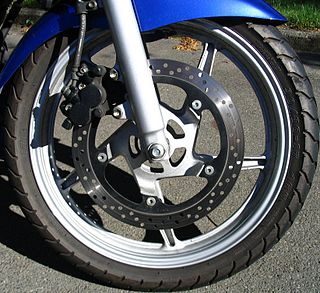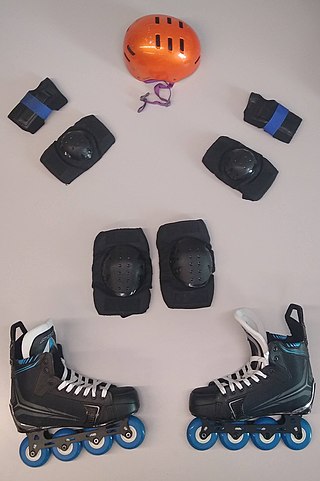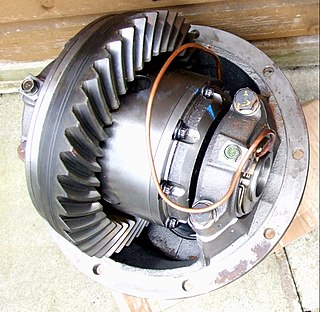
A clutch is a mechanical device that allows the output shaft to be disconnected from the rotating input shaft. The clutch's input shaft is typically attached to a motor, while the clutch's output shaft is connected to the mechanism that does the work.

A drum brake is a brake that uses friction caused by a set of shoes or pads that press outward against a rotating bowl-shaped part called a brake drum.

A brake is a mechanical device that inhibits motion by absorbing energy from a moving system. It is used for slowing or stopping a moving vehicle, wheel, axle, or to prevent its motion, most often accomplished by means of friction.

Inline skates are a type of roller skate used for inline skating. Unlike typical roller skates, which have two front and two rear wheels, inline skates typically have two to five wheels arranged in a single line. Some, especially those for recreation, have a rubber "stop" or "brake" block attached to the rear of one or occasionally both of the skates so that the skater can slow down or stop by leaning back on the foot with the brake skate.

Roller skating is the act of travelling on surfaces with roller skates. It is a recreational activity, a sport, and a form of transportation. Roller rinks and skate parks are built for roller skating, though it also takes place on streets, sidewalks, and bike paths.

Inline speed skating is the roller sport of racing on inline skates. The sport may also be called inline racing or speed skating by participants. Although it primarily evolved from racing on traditional roller skates, the sport is similar enough to ice speed skating that many competitors are known to switch between inline and ice speed skating according to the season.
Understeer and oversteer are vehicle dynamics terms used to describe the sensitivity of the vehicle to changes in steering angle associated with changes in lateral acceleration. This sensitivity is defined for a level road for a given steady state operating condition by the Society of Automotive Engineers (SAE) in document J670 and by the International Organization for Standardization (ISO) in document 8855. Whether the vehicle is understeer or oversteer depends on the rate of change of the understeer angle. The Understeer Angle is the amount of additional steering that must be added in any given steady-state maneuver beyond the Ackermann steer angle. The Ackermann Steer Angle is the steer angle at which the vehicle would travel about a curve when there is no lateral acceleration required.
Automobile handling and vehicle handling are descriptions of the way a wheeled vehicle responds and reacts to the inputs of a driver, as well as how it moves along a track or road. It is commonly judged by how a vehicle performs particularly during cornering, acceleration, and braking as well as on the vehicle's directional stability when moving in steady state condition. Numerous factors affect handling

A locking differential is a mechanical component, commonly used in vehicles, designed to overcome the chief limitation of a standard open differential by essentially "locking" both wheels on an axle together as if on a common shaft. This forces both wheels to turn in unison, regardless of the traction available to either wheel individually.
A bootleg turn is a driving maneuver intended to reverse the direction of travel of a forward-moving automobile by 180 degrees in a minimum amount of time while staying within the width of a two-lane road. This maneuver is also known as a smuggler's turn, powerslide, or simply bootlegger.

A burnout is the practice of keeping a vehicle stationary and spinning its wheels, the resultant friction causing the tires to heat up and smoke.

Trail braking is a driving and motorcycle riding technique where the brakes are used beyond the entrance to a turn (turn-in), and then gradually released. Depending on a number of factors, the driver fully releases brake pressure at any point between turn-in and the apex of the turn.
A freestyle skateboarding trick is a trick performed with a skateboard while freestyle skateboarding. Some of these tricks are done in a stationary position, unlike many other skateboarding tricks. The keys to a good freestyle contest run are variety, difficulty, fluidity, and creativity. This is an incomplete list, which includes most notable tricks.

A slide is a skateboarding trick where the skateboarder slides sideways either on the deck or the trucks.
Clutch control refers to the act of controlling the speed of a vehicle with a manual transmission by partially engaging the clutch plate, using the clutch pedal instead of the accelerator pedal. The purpose of a clutch is in part to allow such control; in particular, a clutch provides transfer of torque between shafts spinning at different speeds. In the extreme, clutch control is used in performance driving, such as starting from a dead stop with the engine producing maximum torque at high RPM.
A wheelspin occurs when the force delivered to the tire tread exceeds that of available tread-to-surface friction and one or more tires lose traction. This leads the wheels to "spin" and causes the driver to lose control over the tires that no longer have grip on the road surface. Wheelspin can also be done intentionally such as in drifting or doing a burnout.

Super Select is the brand name of a four-wheel drive system produced by Mitsubishi Motors, used worldwide except for North America, where it was initially known as Active-Trac. It was first introduced in 1991 with the then-new second generation of the Mitsubishi Pajero.

Road slipperiness is a condition of low skid resistance due to insufficient road friction. It is a result of snow, ice, water, loose material and the texture of the road surface on the traction produced by the wheels of a vehicle.
British Ice Skating is the national governing body of ice skating within the United Kingdom. Formed in 1879, it is responsible for overseeing all disciplines of ice skating: figure skating ; synchronised skating; and speed skating.
An automobile skid is an automobile handling condition where one or more tires are slipping relative to the road, and the overall handling of the vehicle has been affected.











